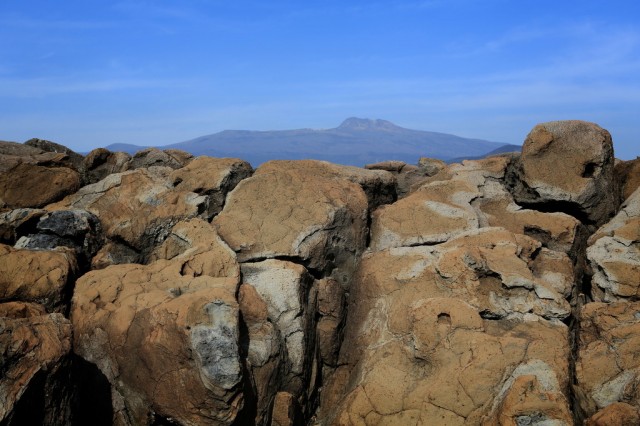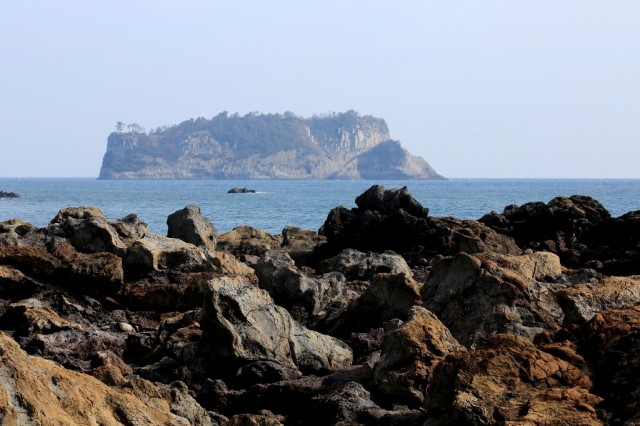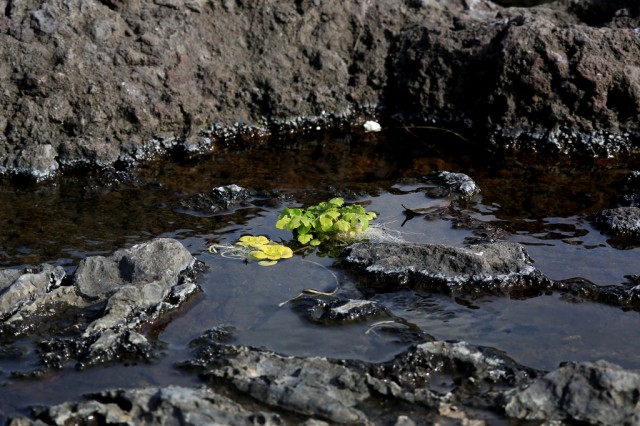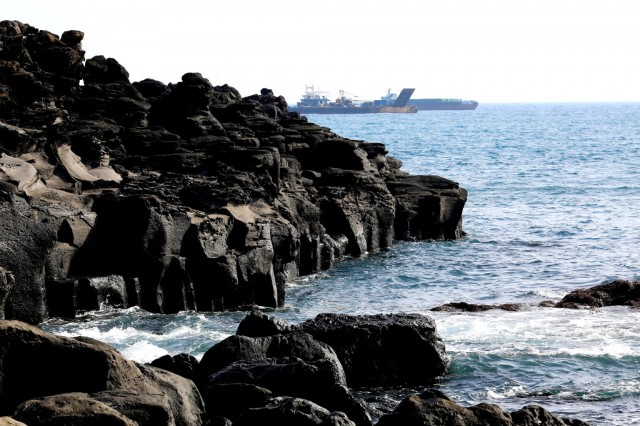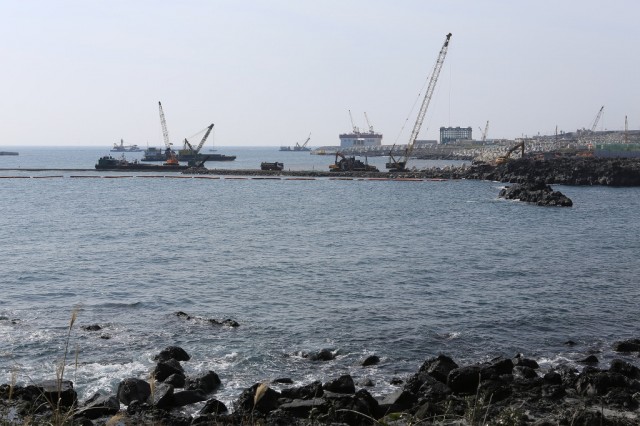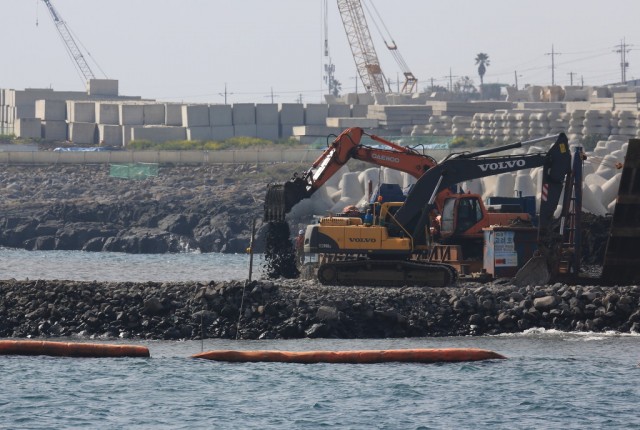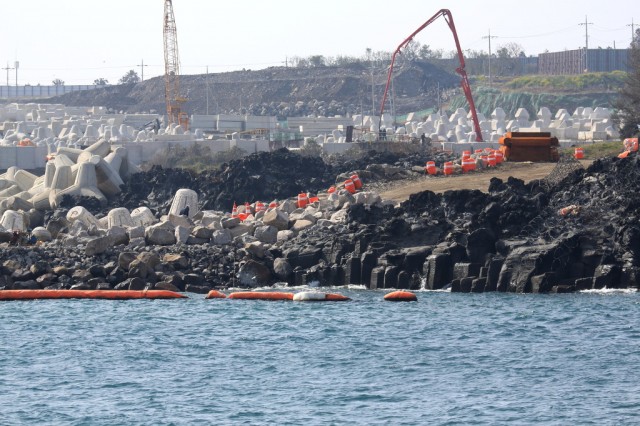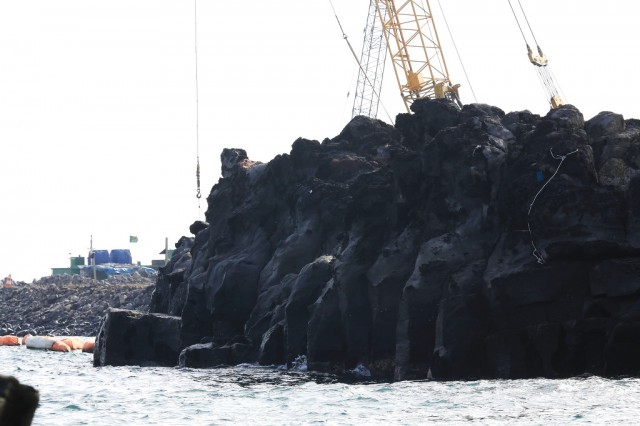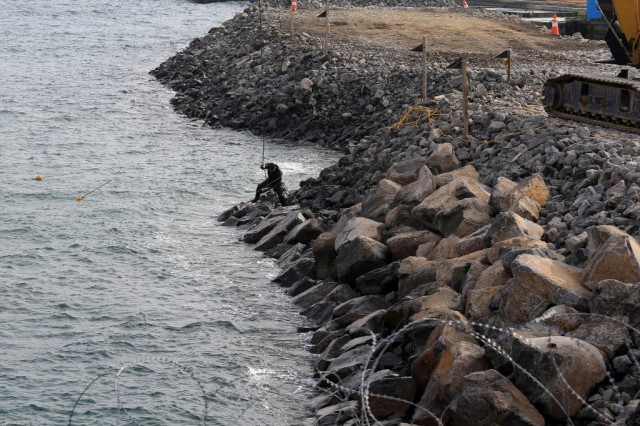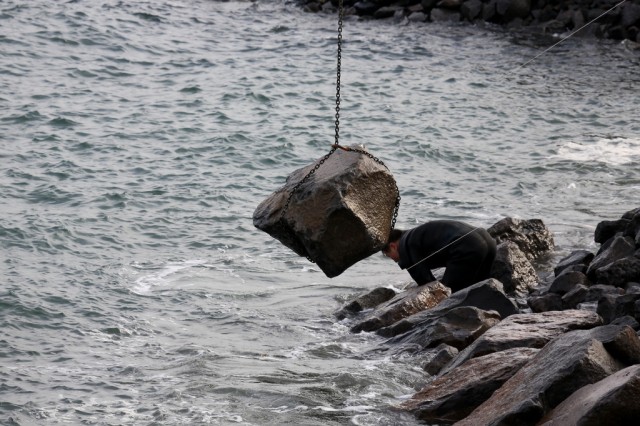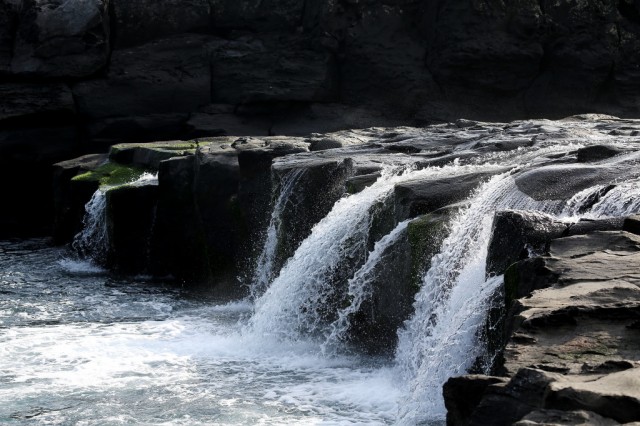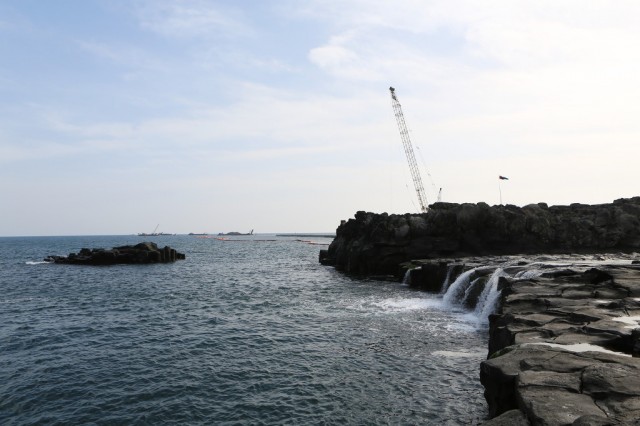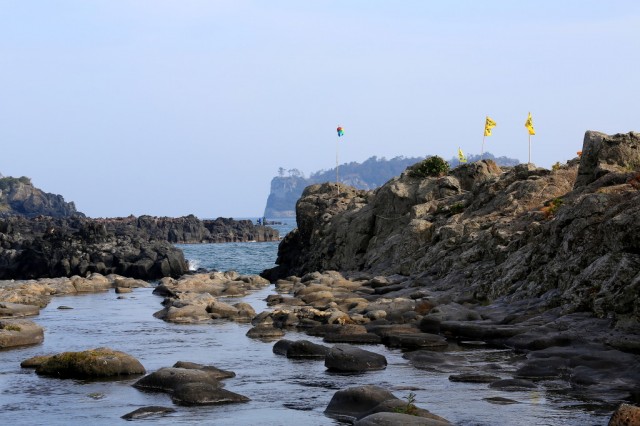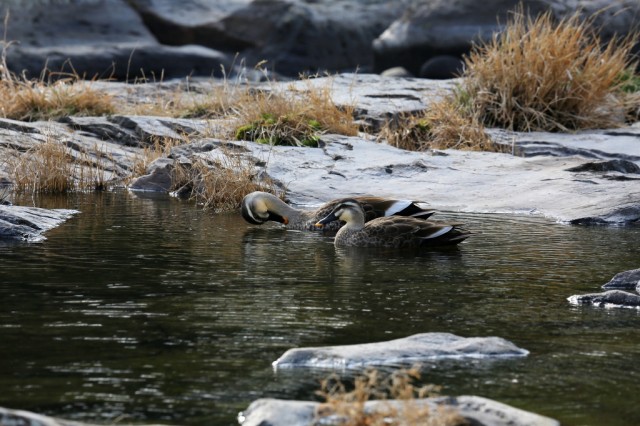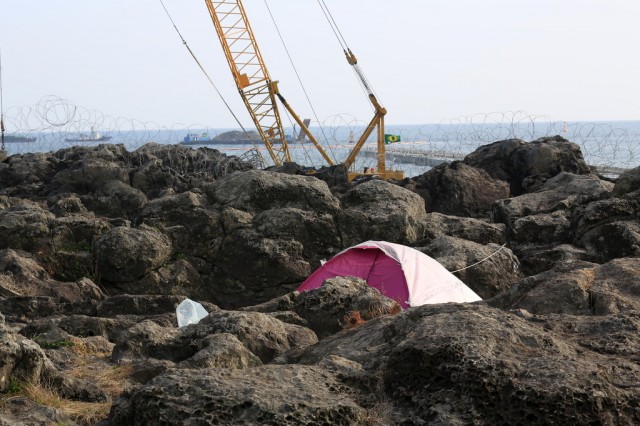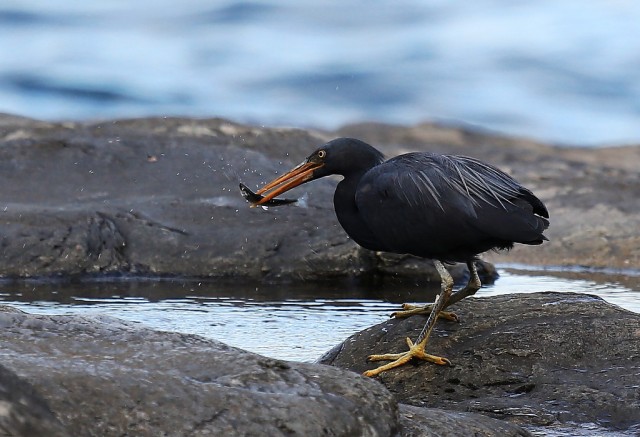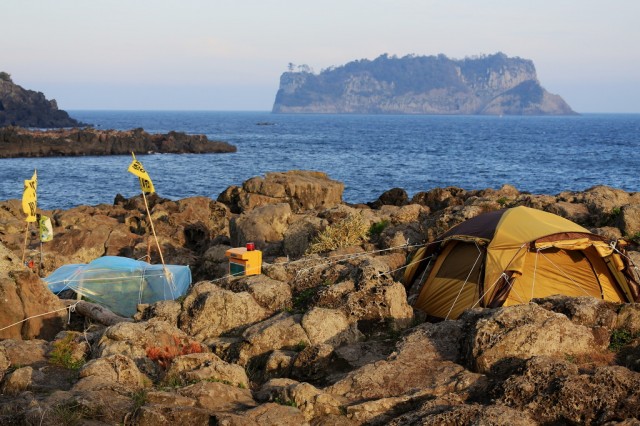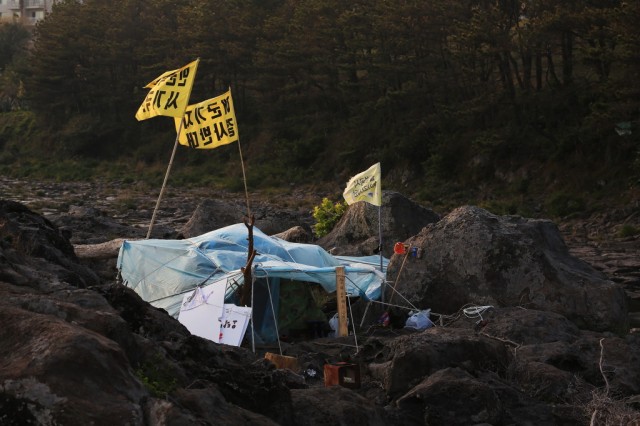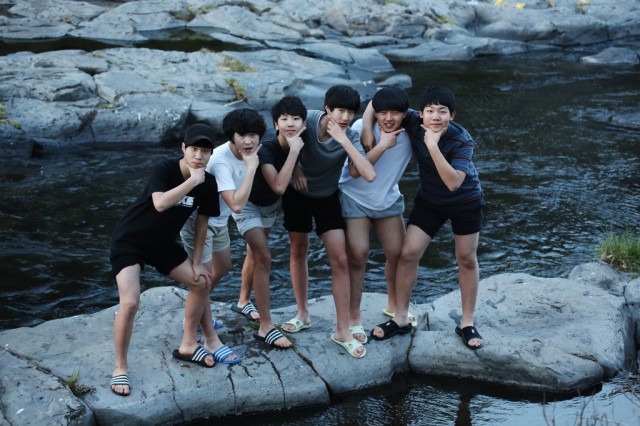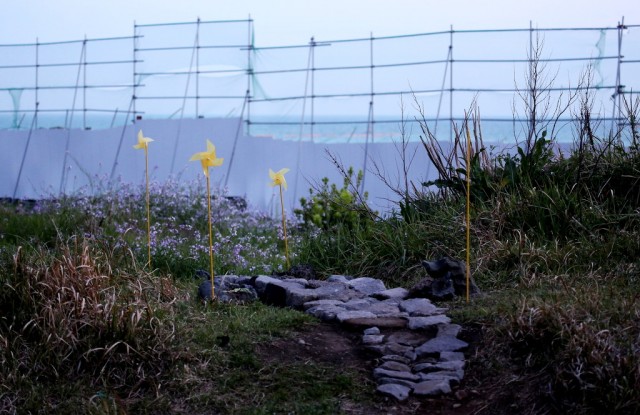The above photos and below translated/ rearranged excerpts are from two sites by Dir. Cho Sung-Bong. One site is titled, “I will skip over sorts of loneliness” and the other is “Reef heron and blue boys”
Regina Pyon has briefly described on some photos:
‘An activist is staying in a tent(blue on the left) on Moetppuri rock, just border of Jeju navy base building site, watching the illegal destruction . . .He is called as Moetppuri Park as his surname is Park. . .The yellow tent is for guests. . . .The reef heron is eating small silver color fish (sweet fish) living in the clean Gangjeong stream. . .’
The rocks in the Soonurikozi resembled the Gureombi Rock.
The red or yellow earth colors.. and the round or gently slopping shapes, too…
Different from the Gureombi Rock, they rise above from the sea so the sea waves do not directly touch them.
Therefore there remain many rocks with the traces of the burnt as they are since erosion from the sea waves are less there.
[..]
Here are the words of a poet and architect, Han Sung-Ho, who is joining the Gangjeong Peace Book Village project, in the interview with the Hankook Ilbo.
Q: There was a court decision that the naval base project is legal and many parts of construction (destruction) have been processed. What will be the meaning of the Peace Book Village project in this reality?
A: [..] The Peace Book village can be a basis to continue opposition struggle. The object of the struggle is not the cement lumps but military power-the violence- within those and that threatens peace. We should fight until those disappear.
(Source: website of the Gangjeong Peace Book Village)
[..]
Gureombi, Moetppuri, Soonurikozi, Saebyolkozi, Binnyokozi, Natgririso, Gangjeong stream, Ackeun stream, Beomseom (Tiger Island), Natkakk and Gangjeong. (*Names of the locations of rocks, streams, Island etc. in and around the village. Many are named by the Jeju dialect.)
[..]
Biosphere Reserve area (UNESCO): designated on Dec. 2002
Cultural treasure protection area (Natural memorial NO. 421, by the Cultural Heritage Administration of Korea): designated in July 2000
Cultural treasure protection area (Natural memorial NO. 442, by the Cultural Heritage Administration of Korea): designated in December 2004
Jeju Island municipal maritime park (Jeju Island): Designated in Oct. 2006
Ecology-excellent village (Ministry of Environment, 2006)
Absolute preservation coastal area (Jeju Island): Issued in April, 2007
Nature Park (Bomok~ Gangjeong, Ministry of Environment): Oct. 15, 2008
( * See here)
[..]
You are building a naval base in such area.
To build one more military base.
You are destroying and killing all those.
[..]
The sea of the Gureombi Rock is entirely muddy water.
Many parts of the 1.2km whole body of the Gureombi Rock are still alive.
The area where one can see green square net is the ‘Halmangmool’ (* The Grandmother’s water)
According to the navy’s land part design of the base, it reads that it would preserve 18% of the Gureombi Rock as the current look.
The location is likely to be from the Halmangmool to the Jinsokkak.
[..]
It was on April 1.
“About 20 m height sea wave tsunami was suddenly pushed into the coastal area of the Gureombi Rock, Gangjeong.
It is told that 18 caissons, 8 barges, 10 cranes, construction vehicles, dump trucks that have been working for the naval base breakwaters were swept away and disappeared without trace.
Fortunately, all the workers in works are told to be all safe.”
[..]
In the Moetppuri,
There became a very small tent to be located.
It is to watch 24 hour illegal maritime construction (destruction).
The guy (Moetppuri Park) in the tent says he washes and uses toilets in the Poonglim resort building nearby across the Gangjeong stream.
It seems like it has been for two months. There is no electricity.
He seems to light darkness gathering sun, moon and star lights..
The small tent is the house of Moetppuri Park
The tent for 5 to 6 people beside it is a tent for anybody.
If you come to Gangjeong, you may drop by and sleep in it without fail.
Hearing the sounds of water, wind, and naval base construction
It reads “there are two people.”
Even though he says he wrote it because he hates people suddenly turn up the cover,
It might be his urgent wish. ^^
[..]
It is Natkkak, the end tip of the Gangjeong stream.
The sweet fishes that have left to the Sea are returning back.
Though they are running back from far away,
The reef heron has been waiting for those.
In spring days, Gangjeong is full of pathetic stories..
It is my favoriate in Gangjeong
We call it common heron in the north.
A reef heron.
[..]
[..] Being damaged without being restored to its original, disclosing its ruins and diseased villain appearance, the Gureombi Rock will reflect the look of human beings’ heart like a mirror. The destroyed Gureombi Rock is my look and our self-portrait. How monstrous it is being destroyed, it is not the Gureombi Rock but ourselves. Therefore, to make alive the Gureombi coast is to make alive ourselves before to make alive the nature.
( Excerpted from a writing by a poet, Kim Gi-Taek, ‘The Gureombi Rock does not say anything’ in the book ‘You, Dear Gangjeong,’ written by 43 writers and recently published.)
Blue boys in the Gangjeong stream.. they are 16 years old.
They are already playing with water. Youth is expectedly different.
“Love you, Gangjeong! Sorry, Gureombi Rock!’
Filters: Photos




